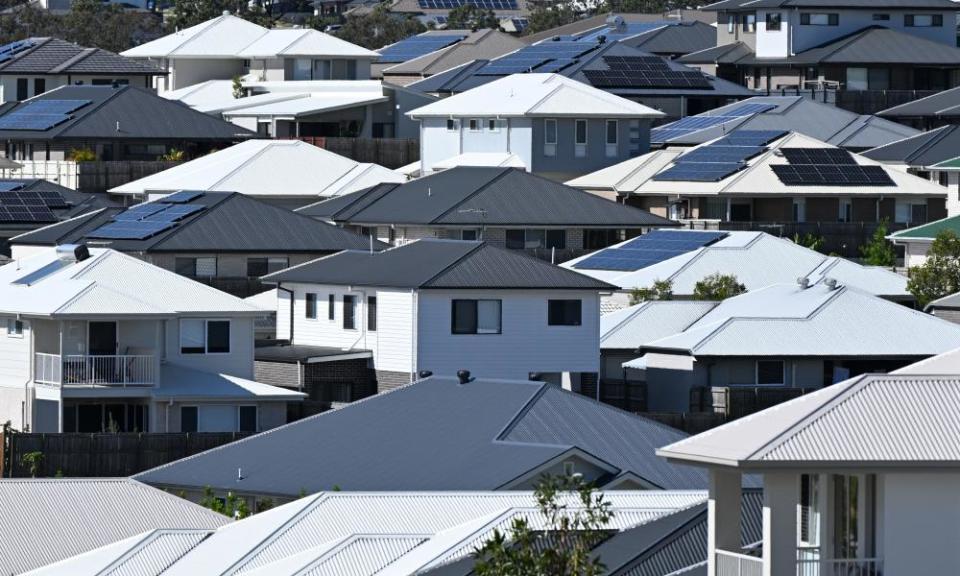The past financial year was brutal for household incomes – and it seems the recovery isn’t coming anytime soon

The triple threat of falling real wages, rising prices of necessities and soaring mortgage repayments has seen people’s living standards plummet in the past two years. The annual release of the state accounts shows that the 2022-23 financial year was a brutal one for households even while the state economies grew.
Related: RBA governor says inflation ‘increasingly homegrown’, suggesting interest rates will remain high
As I’ve said before, while GDP is a useful number to gauge how the economy is going, you can’t eat GDP. It does not measure much that is important in life and it also counts some things that only tangentially affect households.
We see much the same with the gross state product (GSP) figures that were released earlier this week.
Across the nation, all states except the Northern Territory (which you can view here) grew quite well:
If the graph does not display click here
New South Wales, South Australia and Western Australia grew especially strongly. NSW accounts for around 30% of Australia’s economy but it made up 37% of the growth of the national economy in 2022-23.
If the graph does not display click here
Even in a per capita sense, only the NT economy went backwards, and that was mostly due to exceptional falls in oil and gas extraction.
As a result, state incomes mostly rose as well. In NSW, state income per capita rose 2%, while they rose 0.9% across the nation. But state income is not household income – it includes profits from increased export prices.
When we look instead at household income and household disposable income (which takes out payments and taxes), the situation is greatly changed:
If the graph does not display click here
Across the nation in 2022-23, real household disposable income per capita fell 5.1% - from a stunning 6.8% fall in SA to a relatively OK, but still awful, 2.6% fall in the ACT.
Real household disposable income is effectively our living standards, and they have been smashed.
And worse, the news from the RBA suggests it will take a while to repair the damage.
Prior to the pandemic, real household disposable income was growing pretty steadily (if historically slowly). The years of ever-lower wages growth had a massive dampening effect on household incomes, but at least it mostly kept going up.
During the pandemic, massive stimulus kept not just the economy going, but also households. That has now been unwound, but we’re not back to where we’d have expected to be before Covid hit – we’re in a worse place:
If the graph does not display click here
And the RBA’s November statement suggests we are unlikely to get back to pre-pandemic trend levels until well beyond 2025.
In June, per capita income was around 2% below where the pre-pandemic trend would have been – that works out to around $1,154 in annual terms.
The first reason for the decline is the end of the pandemic stimulus.
Across the nation the per capita level of social assistance benefits fell $965 in 2022-23. The biggest fall occurred in Queensland, where social assistance on average fell $1,088:
If the graph does not display click here
But while this was to be expected given we are no longer in lockdown, the second and bigger hit in the past year to household income has been interest rates rises.
In 2022-23, the ratio of household interest paid on dwellings relative to household disposable income went from 3.1% to 6.1%:
If the graph does not display click here
That is a massive shock to the system. The biggest shock was for households in Victoria where the ratio went from 3.6% to 7.3%. The one-year jump in the level of interest being paid relative to income is equivalent to the seven years’ worth of rises in the cost of servicing home loans from 1999-2000 to 2006-07.
Related: November interest rate rise was needed to avoid risk of larger future increases, RBA says
But the reduction in social assistance and the big rise in interest payments would not have been so bad had there also been a strong rise in the level of wages.
In real terms, however, the compensation of employees per capita rose just 0.9% across Australia, bolstered mainly by the boost in NSW. In WA, SA and the two territories, real compensation per capita fell, while in Victoria it was flat.
If the graph does not display click here
The state accounts show just how important it is to care about what matters. It is good to see economic and national income growth, but if households are going backwards, then something is greatly askew.
They also reveal that the biggest impact of rising prices and interest rates has been on households, which are having to deal with a massive increase in their repayments at the same time as stimulus payments were being withdrawn and wage growth has been generally below inflation.
Cost of living is always a major factor in elections – but more important is the standard of living. And right now, households are going backwards in every state and every territory.
Greg Jericho is a Guardian columnist and policy director at the Centre for Future Work

 Yahoo Finance
Yahoo Finance 